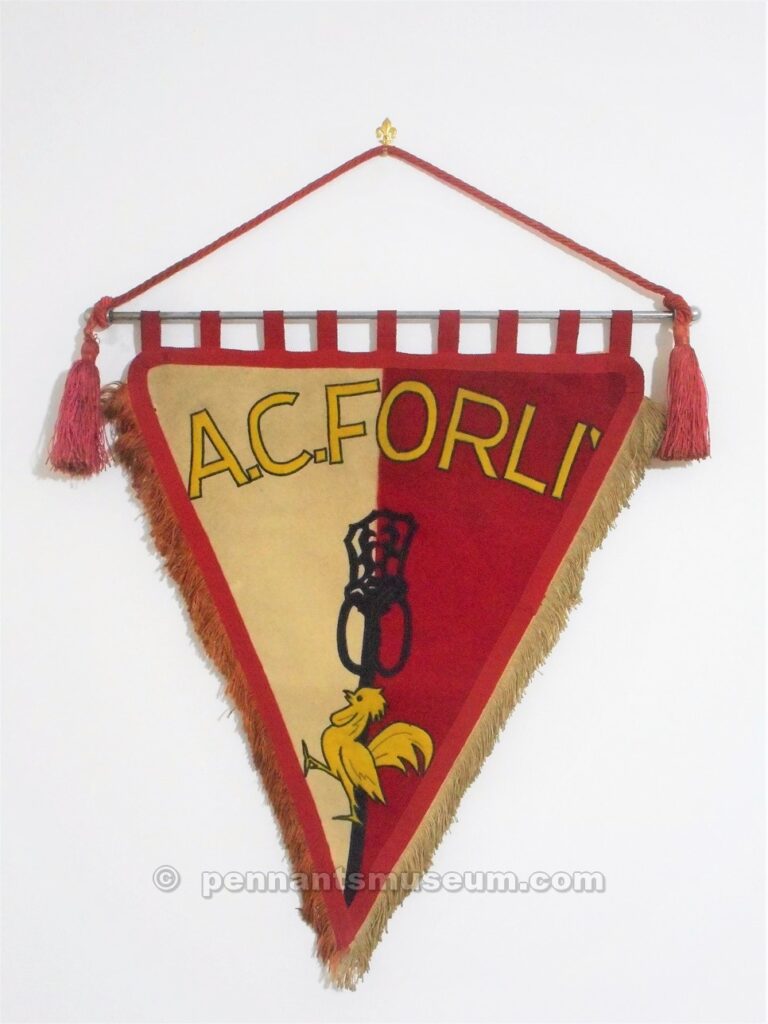I biancorossi del Forlì nascono nel 1919 e subito dopo la fondazione si iscrivono nei ruoli della FIGC partecipando ai suoi campionati. Nel corso della loro storia la squadra forlivese ha raggiunto il massimo livello quando disputò, nella stagione 1946 – 1947, il campionato di Serie B, il primo organizzato dalla Lega Calcio a cui parteciparono sessanta squadre suddivise in tre gironi a carattere regionale. Dopo tale exploit, il Forlì giocò in vari campionati corrispondenti all’attuale serie C ovvero in D, categorie dove è rimasta per la gran parte della sua storia sportiva. Nei gagliardetti del Forlì è rappresentata la tradizione e l’attaccamento al territorio della squadra. Il bianco e il rosso sono tonalità riprese dai colori del gonfalone cittadino mentre il gallo e la caveja sono anche l’evidenza della Romagna essendone i simboli rappresentativi. Mentre per il galletto non esistono dubbi, per la caveja vale la pena spendere alcune parole per specificarne la sua funzione e tradizione. Caveja è una parola in romagnolo che tradotta in italiano starebbe per cavicchia. Essa è un attrezzo in ferro battuto con la parte superiore terminante con un’asta nel cui trovavano posto figure allegoriche, disegni di animali, come ad esempio il galletto, ovvero simboli religiosi oltre che anelli. Nella tradizione contadina romagnola questo arnese veniva impiegato per fissare le due componenti lignee (giogo e timone) dell’aratro che veniva apposto sui buoi che provvedevano all’aratura dei campi.
Nel corso degli anni da semplice attrezzo agricolo, la caveja è diventato, in gran parte per una tradizione scaramantica popolare, un vero e proprio simbolo propiziatorio e di buon auspicio. In effetti veniva utilizzato per scongiurare il maltempo e nelle case dei novelli sposi quale simbolo di prosperità. Nella tradizione romagnola all’attrezzo era anche abbinato il suono caratteristico degli anelli tintinnanti durante il movimento tanto che in alcune zone del forlivese questo simbolo venne anche ribattezzato come “caveja canterina”.
FORLÌ A.C. ROMAGNA AND ITS SYMBOLS
The white and red from Forlì were born in 1919 and immediately the foundation enroll in the roles of figc participating in its championships. Throughout their history the Forlivese team reached the highest level when it played, in the 1946–1947 season, the Serie B championship, the first organized by the Football League in which sixty teams divided into three regional group teams participated. After this season, Forlì played in various leagues corresponding to the current C or in D, categories where it remained for most of its sporting history. In the Forlì pennants is represented the tradition and attachment to the territory of the team. White and red are shades taken from the colors of the city banner while the cockerel and the caveja are also the evidence of Romagna being the representative symbols. While for the cockerel there is no doubt, for the caveja it is worth spending a few words to specify its function and tradition. Caveja is a word in dialect that translated into Italian would be for caviar. It is a wrought iron tool with the upper part ending with a rod in which there were allegorical figures, animal drawings, such as the cockerel, or religious symbols as well as rings. In the Romagna peasant tradition this tool was used to fix the two wooden components (yoke and rudder) of the plow that was affixed to the oxen that provided the ploughing of the fields.
Over the years as a simple agricultural tool, the caveja has become, largely due to a popular scaramantic tradition, a real propitiatory and auspicious symbol. In fact, it was used to ward off bad weather and in the homes of newlyweds as a symbol of prosperity. In the Romagna tradition the tool was also combined with the characteristic sound of the tinkling rings during the movement so much that in some areas of the city of Forlì this symbol was also renamed as “singing caveja“.


